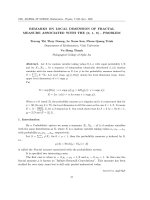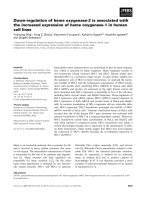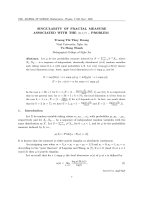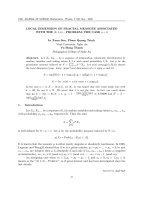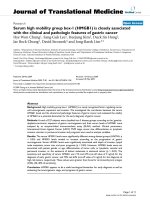Diversity of mold associated with the rotting of peanut (Arachis Hypogaea) during storage in some markets of Douala cameroon
Bạn đang xem bản rút gọn của tài liệu. Xem và tải ngay bản đầy đủ của tài liệu tại đây (696.89 KB, 9 trang )
Int.J.Curr.Microbiol.App.Sci (2019) 8(4): 1406-1414
International Journal of Current Microbiology and Applied Sciences
ISSN: 2319-7706 Volume 8 Number 04 (2019)
Journal homepage:
Original Research Article
/>
Diversity of Mold Associated with the Rotting of Peanut (Arachis Hypogaea)
during Storage in Some Markets of Douala Cameroon
Mounbain Francis, Tchameni Séverin, Ntengna Yonkeu Fabrice, Jazet Dongmo Pierre
Micheal, Sameza Modeste Lambert and Tchoumbougnang François*
University of Douala, PO Box 24157, Douala, Cameroon
*Corresponding author
ABSTRACT
Keywords
Pathogens,
Aspergillus,
Fusarium,
Penicillum, Mucor,
Rhizopus stonifer
and Rhizoctonia
solani
Article Info
Accepted:
12 March 2019
Available Online:
10 April 2019
During storage, peanut seeds face many problems including deterioration that creates
favorable conditions for mold growth and mycotoxin production. This study describes the
diversity of molds responsible for groundnut rot during commercialized in the city markets
of Douala-Cameroon. Peanut samples were collected in a ten markets in the city of
Douala. It has been noted that the postharvest fungal flora of groundnuts in the city of
Douala is composed of various genre of molds. Many fungal species have been isolated
and identified on peanut seeds commercialized in the study markets of the city of Douala.
A total of six thousand fungal isolates (6000) were obtained in post-harvest culture. The
main species are: Aspergillus flavus, Aspergillus niger, Fusarium oxysparum, Fusarium
solani, Fusarium vinale, Penicillium, Mucor, Rhizopus stonifer and Rhizoctonia solani.
Aspergillus is the most common genus (52%), of all samples whatever the geographic
origin. All fungal groups are present in all markets of the city of Douala, and only differ in
proportion.
Introduction
In Cameroon, agriculture contributes for
about 22.9% of gross domestic product and
represents the first employer with 62% of the
active population Anonymous (2015). It is
based on the growing cereals, starchy plants
and legumes. As most of seed legumes,
groundnuts occupy a place of choice in
human nutrition Kouadio (2007). These seeds
contain about 45-50% lipids, 25-30% protein,
12% carbohydrates, 3% fiber, water, minerals
and vitamins Annerose (1990).
In Cameroon, groundnuts rank second after
cotton in terms of economic profitability and
this crop is used both as a cash crop and as a
food or subsistence crop Magrin (2003).
Despite its nutritional, economic and positive
effects, the different peanut varieties are the
preferred substrate for molds, especially the
genus Aspergillus Schmale et al., (2005).
These attacks do not only affect the yield and
nutritional value during storage, but also
human health. Research studies in West
Africa has referred to the attack and loss of
stocks of cereals and legumes by insects and
1406
Int.J.Curr.Microbiol.App.Sci (2019) 8(4): 1406-1414
mycotoxins, which in the tropics are
responsible for losses of up to 30% Philogène
et al., (1989), Ratnadass et al., (1989),
Ashamo (2006) Tagne et al., (2003).
However, in Cameroon, no work has been
done to our knowledge on the diversity of
molds that attack peanuts sold in the markets
of the city of Douala.
Therefore, the objective of this study was to
describe the diversity of molds responsible for
groundnut rot during commercialized storage
in the city markets of Douala-Cameroon.
More specifically, to make a survey of
varieties and mode of peanuts contamination
in the study markets of Douala; to
characterize (morphological and microscopic)
the molds responsible for the rot of the
different varieties of peanuts (Arachis
hypogaea) sold in the city of Douala.
chloramphenicol as antibacterial according to
the method described by Foko and Sougnabe
(1991). Infected peanut seeds were seeded
aseptically in Petri dishes containing 10 mL
of Sabouraud Dextrose Agar (SDA)
supplemented with chloramphenicol. The
culture was incubated during 3-5 days with
cooler set at 25 ° C in order to observe the
growth of the colonies of which numerous
colonies of molds of various genus were
observed and the percentage of contamination
evaluated.
The operation was repeated many times to
obtain pure culture of the isolate. Identity of
the mold isolates was based on macroscopic
and microscopic criteria as described by
Jinyoung Lim et al., (2002), Agrios
(2004) and Sameza et al., (2014).
Results and Discussion
Materials and Methods
A survey form was established to collect
informations on the sold varieties groundnuts,
the conditions and their mode of storage.
From the infected peanut seeds used in this
study, mold that attack these foodstuffs where
isolated and identified.
Peanut sampling
We sampled in ten major markets (Central,
Dakar, Deido, Mabanda, Ndogpassi, New –
bell, Sandaga, Bonamoussadi, Bonassama,
PK 14) of the city of Douala. The collections
were made during the period from January to
June 2016 for a sample of six thousand (6000)
on
5
peanut
varieties
the
most
commercialized as show in Figure 1.
Isolation and identification of molds
Isolation of molds was done by direct contact
on culture medium using Sabouraud Dextrose
Agar
(SDA)
supplemented
with
The survey of varieties and peanut
contamination in the study markets of Douala
city revealed that five(5) varieties of peanut
exist, three (3) are abundant in the city with a
frequency of 47%. The most widely
consumed and commercialized varieties are
Garoua (40%), Makmak (37%) and Yaounde
(20%) (Figure 2A). The most common
pathogens that attack groundnut are molds
(52%), weevils (19%) and bruchids (17%)
(Figure 2B).
Morphological
and
microscopic
characteristics of the main fungal species
isolated from peanuts sold in the city of
Douala
Many fungal species were isolated and
identified on commercialized peanut seeds in
the study markets of the city of Douala. The
main species are: Aspergillus flavus,
Aspergillus niger, Fusarium Spp, Penicillium
sp and Rhizoctonia Sp.
1407
Int.J.Curr.Microbiol.App.Sci (2019) 8(4): 1406-1414
Aspergillus flavus
Aspergillus flavusin pure culture has shown
that the granular colony is white the first two
days and then takes on a yellow, yellow or
brown green color; the reverse of the dish is
colorless
(Figure
3A).
Microscopic
examination of the culture showed that
conidiophores are swollen at the top and have
many conidial-bearing cells. Conidia are
hyaline and arranged in long chains or
individualized (Figure 4A).
Aspergillus niger
Macroscopic examination of A. niger shows
between the 2nd day a first white thallus then
takes towards the 4th day of culture a black
shade surrounded with white (Figure 3B). The
microscopic observation shows a fan structure
with small, round and black spores (Figure
4B).
Fusarium oxysparum
In 4 day culture, the mycelium is cottony and
white (Figure 3C). On microscope, two types
of conidia are observed: microconidia, short
and generally abundant, unicellular and
macroconidia must slightly curved (Figure
4C).
Rhizoctonia solani
Rhizotonia solani colonies are cottony with a
greyish to black coloring and the coating of
the dish dark black (Figure 3D). On
microscope, the mycelium is partitioned and
presents a slight constriction at the level of
the septa; it’s provided by with side forming a
right angle (Figure 4D).
surrounded by a white part but that become
dark and powdery while getting old (Figure
3E). At the microscopic level, the
conidiophores are more or less erect,
partitioned, with a series of branches that
gives a characteristic structure in the form of
brush producing long chains of conidia
(Figure 4E).
Rhizopus stolonifer
Rhizopus stolonifer gives very invasive
colonies on the surface of the medium.
Morphologically, it presents a white thallus,
filamentous and aerial (Figure 3F). At the
microscopic level, many spores called
sporangiospore are enclosed in sporangia
(Figure 4F).
Mucor sp.
Mucor Sp. colonies are generally downy,
invasive and greyish white to yellowish in
color. Conidiophores are generally straight,
entangled each in the other (Figure 3G). At
their extremities, they give birth to a
sporangium containing numerous conidia.
Conidia are spherical, smooth and variable
sizes (Figure 4G).
Fusarium nivale
Fusarium nivale colonies consist of a sparse
mycelium, very tenuous, first white then
turning yellow and finally brown (Figure 3H).
Microscopically, there are no microconidia
and the macroconidia are short, thick, hyalin,
uniformly curved, one side being straight and
the other curved. Conidia generally have 3 – 4
spetas (Figure 4H).
Penicillium sp.
Distribution of isolated molds of peanut
seeds sold in study markets
Penicillium sp. isolate obtained in young
culture have a compact thallus, green
Figure 5 shows the diversity of isolated molds
of different peanut samples collected in the
1408
Int.J.Curr.Microbiol.App.Sci (2019) 8(4): 1406-1414
city of Douala. Several postharvest fungal
isolates were grown in culture of which the
most common genus are Aspergillus (52%),
Fusarium (21%) and Penicillium (15%).
Geographical distribution of fungal genus
The distribution of the main type’s genus of
mold according to the main sampling sites is
shown in Figure 6, from which all samples are
found to be contaminated with mold and
differ only in proportion. Thus in each of
these markets, the most important genus is
Aspergillus with the most important
proportion to the Central market (68%)
compared to 58 and 57% for the Dakar and
Sandaga markets respectively
Distribution of fungal genus according to
the peanut varieties recorded in the city of
Douala
The figure 7 shows the distribution of fungal
genus according to the varieties of peanuts
sold in the markets of the city of Douala. It is
noted that the most contaminated varieties are
Garoua, Makmak and Yaounde. These by the
molds dominance of the genus Aspergillus,
Fusarium and Penicillium (Figure 7).
Despite the healthy appearance of peanut
seeds sold in the city of Douala, they have
been found to be contaminated by various
fungal genera. This contamination is due to
the initial charge in spores. Tahani et al.,
(2008) which after incubation find the
favorable medium for their germination and
the formation of mycelia. This shows that
reducing the water content of peanut seeds by
drying before storage does not eliminate mold
spores, but makes their development
unfavorable. If the storage conditions are
unfavorable, these molds are factors of bio
deterioration affecting the quality of the
seeds. Furthermore, groundnut, by its high
lipid and protein content, is a suitable medium
that provides to the mold the nutrients needed
for growth (Kassemi, 2006). Under the action
of enzymes, complex polymers such as starch
are transformed into simple molecules used
by mold. Tabuc (2007), which could explain
the high fungal density detected.
The
genus
Aspergillus,
Fusarium,
Penicillium, Rhizoctonia, Rhizopus and
Mucor represent the common mycoflora of all
collected samples. Previous studies have
shown that peanut seed storage molds in India
included the genus Alternaria, Aspergillus,
Cladosporium, Colletotrichum, Fusarium,
Penicillium, Rhizoctonia, Stemphylium and
Trichoderma. Sud et al., (2005). Alternaria,
Aspergillus,
Fusarium,
Moniliella,
Penicillium and Rhizopus genus were isolated
from Algerian samples. Djabali (2012).
These results indicate that seed fungal
contamination during storage may be related
to hydrothermal conditions.(Wilson et al.,
2002) because the affected regions are
subjected to completely different climatic
conditions which would influence the fungal
distribution. However, we can notice that the
common fungal genera to all these regions are
Aspergillus, Fusarium and Penicillium, with a
predominance for the genus Aspergillus and
Penicillium. Botton et al., (1990) have indeed
pointed out that during storage, a flora
consisting of less cellulolytic and more
osmophilic fungi are developing, which cause
acidification of the substrate; these are mainly
Aspergillus and Penicillium which are two
genus that proliferate mainly during storage
on substrates whose low humidity such as
peanuts during storage and products with
reduced water activity (Castegnaro and Pfohl
Leszkowicz, 2002).
1409
Int.J.Curr.Microbiol.App.Sci (2019) 8(4): 1406-1414
Fig.1 Peanut sampling (A, B, C, D, E represent Garoua, Makmak, Village,Yaounde andBafia
peanut respectively)
A
C
A
B
A
D
A
E
A
Fig.2 Varieties of peanut identified (A) and contaminant distribution during peanut storage (B)
Fig.3 Aspect of different colonies of mold associated with the rotting of peanut seed
(Arachishypogaea) during storage sold in the markets of Douala. A: Aspergillus flavus; B:
Aspergillus niger; C: Fusariumoxysparum; D: Rhizoctoniasolani;E: Penicilliumsp;F:
Rhizopusstolonifer; G: Mucor Sp. and H: Fusariumnivale
A
B
C
D
E
F
G
H
1410
Int.J.Curr.Microbiol.App.Sci (2019) 8(4): 1406-1414
Fig.4 Microscopic observation of the main fungal species isolated from peanuts sold in
Microconidia and macroconidia of Fusarium oxysparum; D: Mycelium of Rhizoctonia solani; E:
Conidiophores producing long chains of conidia of Penicillium sp; F:Sporangiospore enclosed in
sporangia of Rhizopus stolonifer; G: Conidiophores of Mucor Sp. and H:Microconidia and
macroconidia of Fusarium nivale
A
E
B
C
D
F
G
H
Fig.5 Diversity and proportion of fungal genus isolated from peanut samples in the city of
Douala
Fig.6 Diversity of different fungal genus according to markets
1411
Int.J.Curr.Microbiol.App.Sci (2019) 8(4): 1406-1414
Fig.7 Distribution of fungal genus according to the peanut varieties recorded in the city of
Douala
The highest contamination of peanut seeds by
Aspergillus and Penicillium in all sampling
sites indicates a potential danger because
there is a possibility of a significant
contamination of a flatoxin and ochratoxin;
similarly, the significant representativity of
the genus Fusarium is also an element of
concern because of the many mycotoxins that
can be produced. In this study, peanut
samples collected from different sites in the
city of Douala are contaminated with identical
mold species with some ready exceptions, but
at different rates. This could be explained by
the fact that these different sampling sites are
submitted to the same climatic conditions. A.
Flavus followed by A. niger were the
predominant fungal species in all peanut
varieties from the sampling sites. These
results show that the quality of the fungal
species present on seeds in stock is related to
the peanut variety and also to the initial spore
load. Therefore, there is a positive correlation
between fungal infestation and seed richness
in these two elements (Abdel Massih, 2007).
In conclusion, findings from our study
showed that there are several contaminations
of the peanut samples. These could be due to
the fact that postharvest fungal flora of
peanuts in the city of Douala is composed of
molds. However, further studies on molecular
characterization to confirm their identification
are needed.
Acknowledgements
The Authors thank the Biochemistry
Laboratory of the Faculty of Sciences of the
University of Douala (Cameroon) for the
realization of this work.
References
Abdel Massih, M., 2007. Mold: identification,
sources of contamination and control
methods. Food technological pole :3.
Annerose, D.J.M., 1990. Research on the
physiological
mechanisms
of
adaptation to drought. Application to
the case of peanut (Arachis hypogeae
L.) grown in Senegal. Thesis.
University of Paris VII., 282 p
Anonymous., (2015). Agricultural policies
around the world: some examples.
Agricultural context and international
relations:
Case
of
Cameroon.
1412
Int.J.Curr.Microbiol.App.Sci (2019) 8(4): 1406-1414
/>Ashamo, M.O., 2006. Relative susceptibility
of some localand elite rice varieties to
the rice weevil, Sitophilusoryzae L.
(Coleoptera: Curculionidae). J. Food
Agric. Environ., 4(1): 249-252.
Botton, B., Breton, A., Fevre M., Gauthier, S.,
Guy, P., Larpent, J.P., Reymond, P.,
Wild Boar, J.J., Vayssier Y., Calf P.
1990. Useful and harmful molds,
Industrial importance, Ed. Masson,
Paris. 512p.
Castegnaro, M., Pfolhl-Leszkowicz, A.2002.
Mycotoxins:
omnipresent
contaminants in animal and human
nutrition. Moll. & Moll. (Eds). Food
safety of the consumer. Lavoisier, Tec
& doc. Lavoisier, Londres, Paris, New
York.: 127-179.
Djabali, S., 2012. Effect of polyphenols on
resistance to fungal infestation in dry
bean grain. Memoir Presented for
graduation from Magister in Food
Science.
Mentouri-Constantine
University. 122Pp.
Foko, J., Sougnabe. 1991. Composition,
infection sites and evolution of
groundnut fungal spermoflora in the
Mayo-kebbi basin (Tchad). Bioscience
Proccess. 2:314 - 317.
Kassemi, N., 2006. Relationship between a
phytophagous insect and its main host
plant: case of the bean weevil
(Acanthoscelides
obtectus)
(Coleoptera bruchidae). Magister
thesis. University of Tlemcen, Algeria.
107p.
Kouadio, A. L., 2007. Interuniversity in
natural risk management: Forecast of
national groundnut production in
Senegal from the agro-meteorological
model AMS and NDVI. ULGGembloux 54 p.
Margin, G., 2003. A subregional food crop:
peanut. In: Atlas Agriculture and
Rural Development of Central African
savannahs. CIRAD / PRASAC. P. 63
– 64
Philogène, B.J. R, Armson, J.T. and Lambert,
J.D.H. 1989.Factors contributing to
the protection of maize against
Sitophilus and Prostephanus attacks.
Cereals in warm regions. Paris:
AUPELF-UREF,
John
Libbey
Eurotext, 47-56
Ratnadssa, A. and Sauphanor, B. 1989.
Losses due to insects on cereals
farmer’s stocks in the coast of ivory.
Cereals in hot regions. Paris: Aupelf
Uref, John Libbey Eurotext. 141-150
Sameza, M.L., Bedine Boat, M.A., Tchameni,
N.S., Nguemnang M.C.L., Jazet,
D.P.M., Fekam, B.F., Menut, C.2014.
Potential use of Eucalyptus globulus
essential oil against Phytophthora
colocaciae, the causal agent of taro
leaf blight. Eur J Plant Phytopathol.
140:243–250.
Schmale, D.G., Arntsen, Q.A., Bergstrom,
G.C., 2005. The forcible discharge
distance of ascospores of Gibberella
zeae. Canadian Journal of Plant
Pathology. 27: 376 - 383.
Sud D., Sharma, O.P., Sharma, P.N. 2005.
Seed mycoflora in kidney bean
(Phaseolus vulgaris L.) in Himachal
Pradesh. Seed Science Research. 33:
103–107.
Tabuc, C., 2007. Fungal flora of different
substrates and optimal conditions of
mycotoxin
production.
Thesis
presented to obtain the title of Doctor
of the National Polytechnic Institute of
Toulouse and the University of
Bucharest. 190p.
Tagne, A., Kongsdal, O., Ngoko, Z., The C.
Mathur,
SB.
2003.Fusarium
pallidorosum in maize samples of
three agro-ecological zones of
Cameroon. Journal of Stored Product
Research. 39: 367-374.
1413
Int.J.Curr.Microbiol.App.Sci (2019) 8(4): 1406-1414
Tahani, N., Elamrani, A. Serghini-Caid, H.,
Ouzouline, M., Khalid, A., 2008.
Isolation and identification of mold
strains reputed toxinogenic. Journal of
Industrial Microbiology Sanitary and
Environmental. 2: 81-91.
Wilson, D.M., Mubatanhema, W., Jurjevic,
Z., 2002. Biology and ecology of
mycotoxigenic Aspergillus species as
related to economic and health
concerns, Adv. Experiment and
Medical Biology. 504: 3-17.
How to cite this article:
Mounbain Francis, Tchameni Séverin, Ntengna Yonkeu Fabrice, Jazet Dongmo Pierre Micheal,
Sameza Modeste Lambert and Tchoumbougnang François. 2019. Diversity of Mold Associated
with the Rotting of Peanut (Arachis Hypogaea) during Storage in Some Markets of Douala
Cameroon. Int.J.Curr.Microbiol.App.Sci. 8(04): 1406-1414.
doi: />
1414

